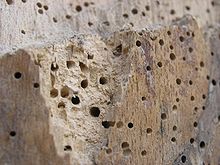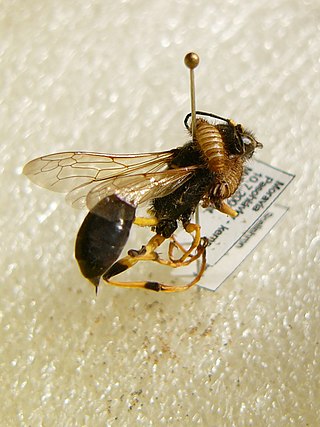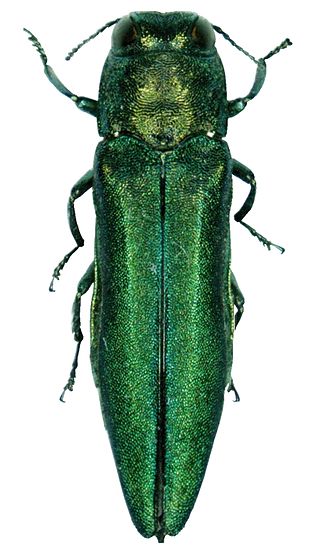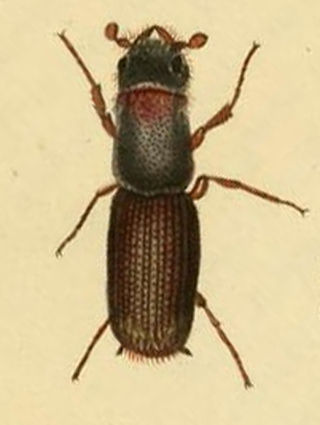
A woodworm is the wood-eating larva of many species of beetle. It is also a generic description given to the infestation of a wooden item (normally part of a dwelling or the furniture in it) by these larvae. [1]

A woodworm is the wood-eating larva of many species of beetle. It is also a generic description given to the infestation of a wooden item (normally part of a dwelling or the furniture in it) by these larvae. [1]
Woodboring beetles with larvae commonly known as woodworm include: [2] [3]

Signs of woodworm usually consist of holes in the wooden item, with live infestations showing powder (faeces), known as frass, around the holes. The size of the holes varies, but they are typically 1 to 1.5 millimetres (5⁄128 to 1⁄16 in) in diameter for the most common household species, although they can be much larger in the case of the house longhorn beetle. Adult beetles that emerge from wood may also be found in the summer months.
Typically the adult beetles lay eggs on or just under the surface of a wooden item. The resulting grubs then feed on the wooden item causing both structural and cosmetic damage. They then pupate and hatch as beetles that then breed, lay eggs and repeat the process, causing further damage.
As these beetles are accustomed to consuming decaying wood in forests, most grubs will prefer wooden items that contain a higher moisture content than that of typical household items.
A building with a woodworm problem in its structure or furniture may also have a problem with excess moisture. The issue could be the result of a lack of ventilation in a roof space, cellar or other enclosed space within an otherwise dry building.
Whilst moisture is a leading factor resulting in a woodworm infestation, some species of woodboring insects, such as the woodboring weevil, are only found where fungal rot has already begun.
Depending on the species involved, woodworm infestation is generally controlled with insecticides. However, some woodworm conditions, such as those caused by the waney edge borer ( Ernobius mollis ), require no treatment at all because the insect will have been killed in the preparation of the wood. [4] Only active infestations require treatment, so it is important to ascertain whether an infestation is still active before treatment is carried out. [3] It is also advisable to investigate and solve possible dampness issues, as dry wood is not usually affected, and wood that remains damp may be reinfected at a later date.
Electrical insect killers, which attract and kill adult beetles before they can breed, may be used along with conventional chemical treatments to kill adult beetles before they can breed, but the effectiveness of such an approach is unknown.
Freezing treatments are quite effective but are costly, take two to three weeks to work and may cause damage. Low-oxygen treatment is also effective but is costly and very time-consuming, taking as long as eight weeks to treat the problem.
In places such as Cambodia, South Africa, the Philippines [5] and Papua New Guinea, woodworms may be considered edible delicacies.[ dubious ][ citation needed ]

A pest is any organism harmful to humans or human concerns. The term is particularly used for creatures that damage crops, livestock, and forestry or cause a nuisance to people, especially in their homes. Humans have modified the environment for their own purposes and are intolerant of other creatures occupying the same space when their activities impact adversely on human objectives. Thus, an elephant is unobjectionable in its natural habitat but a pest when it tramples crops.

Bookworm is a general name for any insect that is said to bore through books.

The emerald ash borer, also known by the acronym EAB, is a green buprestid or jewel beetle native to north-eastern Asia that feeds on ash species. Females lay eggs in bark crevices on ash trees, and larvae feed underneath the bark of ash trees to emerge as adults in one to two years. In its native range, it is typically found at low densities and does not cause significant damage to trees native to the area. Outside its native range, it is an invasive species and is highly destructive to ash trees native to Europe and North America. Before it was found in North America, very little was known about emerald ash borer in its native range; this has resulted in much of the research on its biology being focused in North America. Local governments in North America are attempting to control it by monitoring its spread, diversifying tree species, and through the use of insecticides and biological control.

The deathwatch beetle is a species of woodboring beetle that sometimes infests the structural timbers of old buildings. The adult beetle is brown and measures on average 7 mm (0.3 in) long. Eggs are laid in dark crevices in old wood inside buildings, trees, and inside tunnels left behind by previous larvae. The larvae bore into the timber, feeding for up to ten years before pupating, and later emerging from the wood as adult beetles. Timber that has been damp and is affected by fungal decay is soft enough for the larvae to chew through. They obtain nourishment by using enzymes present in their gut to digest the cellulose and hemicellulose in the wood.

Powderpost beetles are a group of seventy species of woodboring beetles classified in the insect subfamily Lyctinae. These beetles, along with spider beetles, death watch beetles, common furniture beetles, skin beetles, and others, make up the superfamily Bostrichoidea. While most woodborers have a large prothorax, powderpost beetles do not, making their heads more visible. In addition to this, their antennae have two-jointed clubs. They are considered pests and attack deciduous trees, over time reducing the wood to a powdery dust. The damage caused by longhorn beetles is often confused with that of powderpost beetles, but the two groups are unrelated. The larvae of the Cerambycidae are white, straight and generally flat-headed, whereas those of the Bostrichidae are white and C-shaped.

The common furniture beetle or common house borer is a woodboring beetle originally from Europe but now distributed worldwide. In the larval stage it bores in wood and feeds upon it. Adult Anobium punctatum measure 2.7–4.5 millimetres (0.11–0.18 in) in length. They have brown ellipsoidal bodies with a prothorax resembling a monk's cowl.

The term woodboring beetle encompasses many species and families of beetles whose larval or adult forms eat and destroy wood. In the woodworking industry, larval stages of some are sometimes referred to as woodworms. The three most species-rich families of woodboring beetles are longhorn beetles, bark beetles and weevils, and metallic flat-headed borers. Woodboring is thought to be the ancestral ecology of beetles, and bores made by beetles in fossil wood extend back to the earliest fossil record of beetles in the Early Permian (Asselian), around 295-300 million years ago.

Hylotrupes is a monotypic genus of woodboring beetles in the family Cerambycidae, the longhorn beetles. The sole species, Hylotrupes bajulus, is known by several common names, including house longhorn beetle, old house borer, and European house borer. In South Africa it also is known as the Italian beetle because of infested packing cases that had come from Italy. Hylotrupes is the only genus in the tribe Hylotrupini.

Ptinidae is a family of beetles in the superfamily Bostrichoidea. There are at least 220 genera and 2,200 described species in Ptinidae worldwide. The family includes spider beetles and deathwatch beetles.

The wharf borer, Nacerdes melanura, belongs to the insect order Coleoptera, the beetles. They belong to the family Oedemeridae, known as false blister beetles. Wharf borers are present in all the states of the USA except for Florida. It takes about a year to develop from an egg to an adult. The name 'wharf borer' comes from the larval stage of this insect, which often lingers on pilings and timbers of wharves, especially along coastal areas. The adult beetles are identifiable via a black band across the end of both elytra. In addition, wharf borers are distinct from other members of the family Oedemeridae due to the presence of a single spur on the tibia of the forelegs and the distance between both eyes. The female beetle oviposits eggs on rotten wood, on which the larvae hatch, burrow, then feed. Adults do not eat and depend on stored energy reserves accumulated as a larva. They are considered a pest because they damage wood used in building infrastructures.
Home-stored product entomology is the study of insects that infest foodstuffs stored in the home. It deals with the prevention, detection and eradication of pests.

Dinoderus minutus, the Bamboo borer, is a species of wood-boring beetle. In tropical regions, it is one of the main pests of bamboo, attracted by the internal starch. It is native to Asia but has spread widely with the trade of infested bamboo wood and bamboo products.

The maize weevil, known in the United States as the greater rice weevil, is a species of beetle in the family Curculionidae. It can be found in numerous tropical areas around the world, and in the United States, and is a major pest of maize. This species attacks both standing crops and stored cereal products, including wheat, rice, sorghum, oats, barley, rye, buckwheat, peas, and cottonseed. The maize weevil also infests other types of stored, processed cereal products such as pasta, cassava, and various coarse, milled grains. It has even been known to attack fruit while in storage, such as apples.

Agrilus auroguttatus is a species of jewel beetle in the United States, known by the common name goldspotted oak borer. It is not native to California, but is native to Arizona. It is a woodboring beetle best known for destroying stands of oak trees in the Cleveland National Forest in San Diego County, California, in the United States. The distribution of this insect in California can be found at CalInvasive website. It was originally considered a subspecies of the Central American species Agrilus coxalis, and much of the literature refers to it by this name, but now it is regarded as a separate species, known only from Arizona and California.

Passandridae, the "parasitic flat bark beetles," are a family of beetles notable for being one of the very few beetle families with larvae that are, as far as known, exclusively ectoparasitic on the immature stages of other beetles and Hymenoptera.

Tetropium fuscum, the brown spruce longhorn beetle, is a species of beetle in the family Cerambycidae. It was described by Johan Christian Fabricius in 1787. Tetropium fuscum is native to Europe and Northern Asia, and has been introduced to Nova Scotia, Canada. Brown spruce longhorn is a pest of spruce trees.
Integrated pest management in museums, libraries, archives and private collections is the practice of monitoring and managing pest and environmental information with pest control methods to prevent pest damage to collections and cultural property. Preserving cultural property is the ultimate goal for these institutions. The pests come in many different forms: insects, mites, rodents, bats, birds, and fungi and the two most common types are insects and fungi. It is widely recommended that every museum have some form of pest control in place and monitoring system to protect their collection and that museums review their storage and museum facilities to determine how to best control and prevent pest infestations while utilizing an Integrated Pest Management plan.

Platypus cylindrus, commonly known as the oak pinhole borer, is a species of ambrosia beetle in the weevil family Scolytinae. The adults and larvae burrow under the bark of mature oak trees. It is native to Europe.

The conservation and restoration of wooden artifacts refers to the preservation of art and artifacts made of wood. Conservation and restoration in regards to cultural heritage is completed by a conservator-restorer.

Polycaon stoutii, the black polycaon or Stout's branch borer, is a species of woodboring beetle in the Bostrichidae family. It is found in North America in British Columbia, the Pacific Coast states, and Arizona, but has spread elsewhere due to the shipping of wood products.
About three hundred different species of wood-boring beetles are known as occurring in our domestic woodwork indoors, but of these only seven are of frequent occurrence, and it is to the larval or grub stage that we apply the description 'woodworm'.[ permanent dead link ]